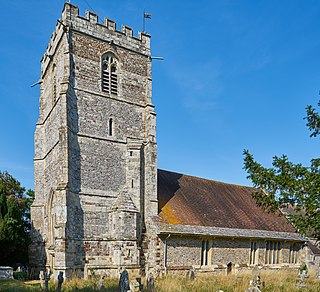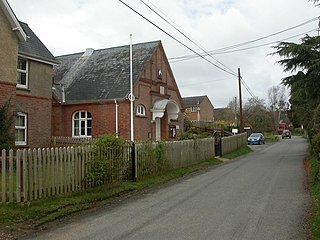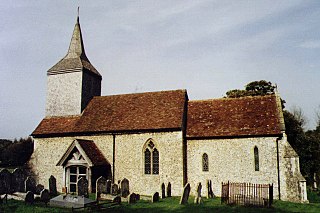
Wiltshire is a ceremonial county in South West England. It borders Gloucestershire to the north, Oxfordshire to the north-east, Berkshire to the east, Hampshire to the south-east, Dorset to the south, and Somerset to the west. The largest settlement is Swindon, and Trowbridge is the county town.

Fordingbridge is a town and broader civil parish with a population of 6,000 on the River Avon in the New Forest District of Hampshire, England, near the Dorset and Wiltshire borders and on the edge of the New Forest, famed for its late medieval seven-arch bridge.

Cranborne is a village in East Dorset, England. At the 2011 census, the parish had a population of 779, remaining unchanged from 2001.

Pentridge is a village and former civil parish, now in the parish of Sixpenny Handley and Pentridge, in the Dorset district, in the ceremonial of Dorset, England, lying in the north-east of the county. It is situated on the edge of Cranborne Chase down a dead-end minor lane just south of the A354 road between the towns of Blandford Forum and Salisbury. In 2001 the parish had a population of 215. The civil parish was abolished on 1 April 2015 and merged with Sixpenny Handley to form "Sixpenny Handley and Pentridge".

Hampshire is a county in Southern England with some notable archaeology and many notable historic buildings.

Wiltshire is a historic county located in the South West England region. Wiltshire is landlocked and is in the east of the region.
Liss is a village and civil parish in the East Hampshire district of Hampshire, 3.3 miles (5.3 km) north-east of Petersfield, on the A3 road, on the West Sussex border. It covers 3,567 acres (14 km2) of semi-rural countryside in the South Downs National Park. Liss railway station is on the Portsmouth Direct line. The village comprises an old village at West Liss and a modern village round the 19th-century station. They are divided by the River Rother. Suburbs later spread towards Liss Forest.

Rockbourne is a village and civil parish in the English county of Hampshire, close to Fordingbridge.

Whitsbury is a village and civil parish in Hampshire, England, close to Fordingbridge. Whitsbury is a part of a group of villages on the edge of the Cranborne Chase and West Wiltshire Downs Area of Outstanding Natural Beauty.

Breamore is a village and civil parish near Fordingbridge in Hampshire, England. The parish includes a notable Elizabethan country house, Breamore House, built with an E-shaped ground plan. The Church of England parish church of Saint Mary has an Anglo-Saxon rood.

Godshill is a village and civil parish and in New Forest National Park in Hampshire, England. It is about 1+1⁄2 miles (2.4 km) east of the town of Fordingbridge and 10 miles (16 km) south of the city of Salisbury.

Martin is a village and civil parish in the New Forest district of Hampshire, England. The nearest town, Fordingbridge, is 7 miles (11 km) to the south-east, and the cathedral city of Salisbury is 12 miles (19 km) to the north-east.

Wellow is a village and civil parish in Hampshire, England that falls within the Test Valley district. The village lies just outside the New Forest, across the main A36 road which runs from the M27 motorway to Salisbury. The nearest town is Romsey, 4 miles (6.4 km) to the east, and the closest city is Southampton, 9 miles (14 km) to the southeast. The parish had a population of 3,239 in the 2021 census.
Cogges is an area beside the River Windrush in Witney, Oxfordshire, 0.5 miles (800 m) east of the town centre. It had been a separate village and until 1932 it was a separate civil parish.

North Charford is a hamlet in the New Forest district, in Hampshire, England, near the Wiltshire border. Historically the name refers to a manor which is now in the civil parish of Breamore on the west bank of the River Avon.

Bickton is a hamlet in the New Forest District of Hampshire, England. It is within the civil parish of Fordingbridge and is situated by the River Avon.

Netley Marsh is a village and civil parish in Hampshire, close to the town of Totton. It lies within the New Forest District, and the New Forest National Park. It is the supposed site of the battle between an invading Anglo Saxon army, under Cerdic and a British army under the probably fictitious king Natanleod in the year 508.

Cranborne Priory is a former priory church in the village of Cranborne, Dorset, England. Founded in 980 as Cranborne Abbey, it became a priory in 1102, remaining that way until it was dissolved in 1540. The tower, nave and aisles from the priory survive to form the Church of St Mary and St Bartholomew, the parish church of Cranborne. The building, which has fragments from the 12th century, is designated a Grade I listed building.
Bull Hill, Dorset, Daggons and Broxhill are adjoining hamlets notable for planted woodland and tree cultivation south of Cranborne Chase and West Wiltshire Downs AONB in Dorset, England. The nearest town is Fordingbridge, about 3 miles (4.8 km) ENE. They are primarily in the civil parish of Alderholt, though some of Bull Hill is in the parishes of Damerham in a north-west projection of Hampshire. The three places have indistinct borders as is normal for hamlets.

Stoke Charity is a small village and former civil parish, now in the parish of Wonston, in the City of Winchester district of Hampshire, England. It is on the River Dever, its nearest town is Winchester, which lies approximately 6.1 miles (9.9 km) south-west from the village. In 1931 the parish had a population of 111.























